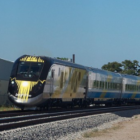Cameron on Transportation
It Can Happen on Trains: ‘We Were Crashing. The Sound of My Own Scream is the Last Thing I Remember’
|
When we get on an airplane we buckle up, read the safety card and are given a demonstration on the oxygen masks and emergency exits. Those things can save lives should something go wrong. But when we get on a train, either Metro-North or Amtrak, we settle into our seat and zone out. We assume we’re safe. That’s what passengers on an Amtrak train in Missouri thought this past week… until their train’s locomotive hit a dump truck on an unguarded private grade crossing and derailed.




